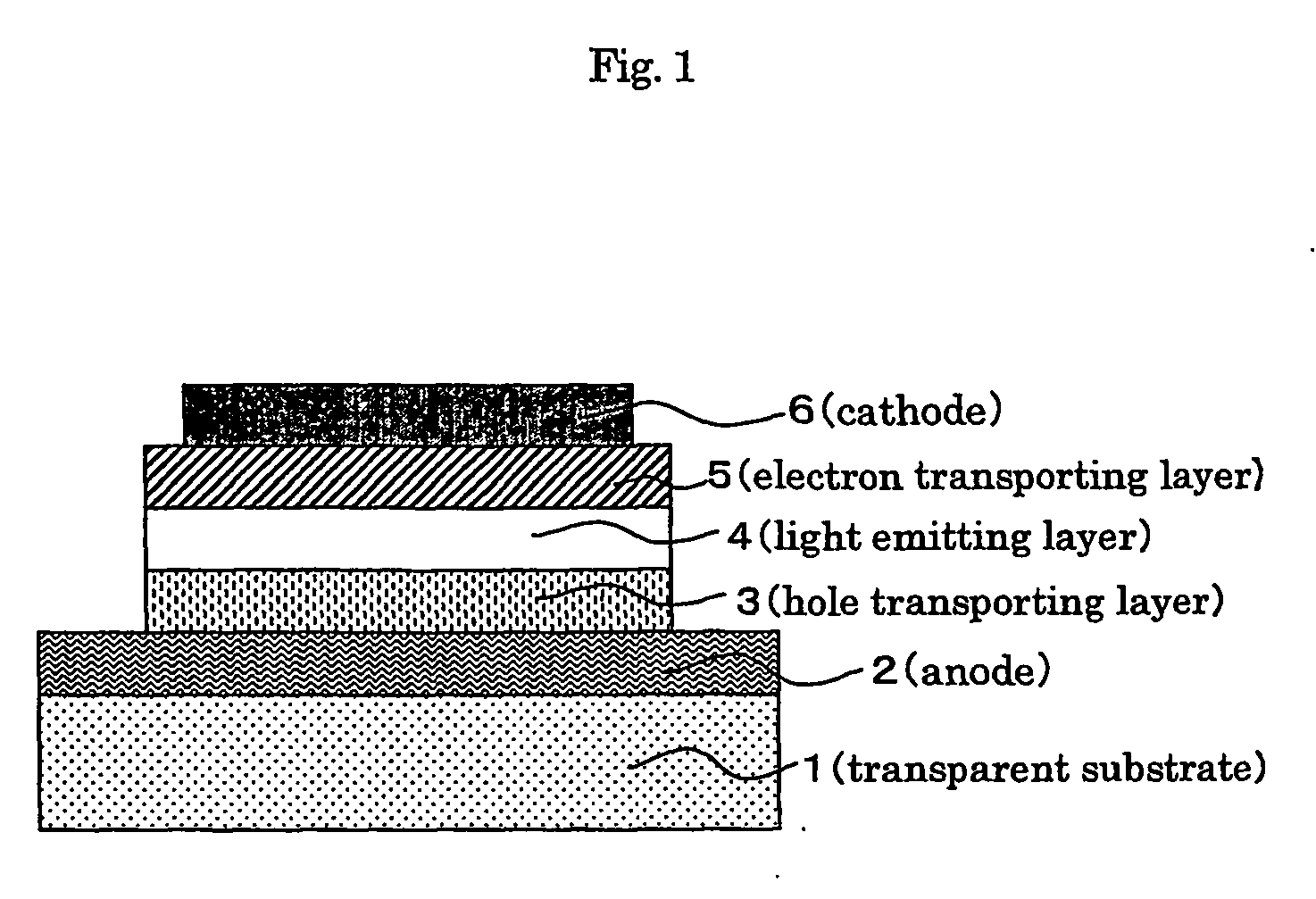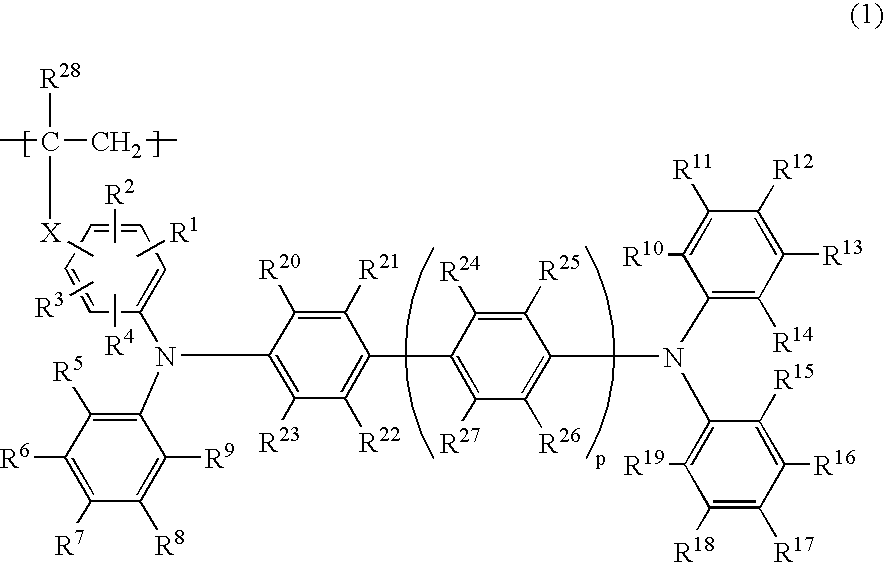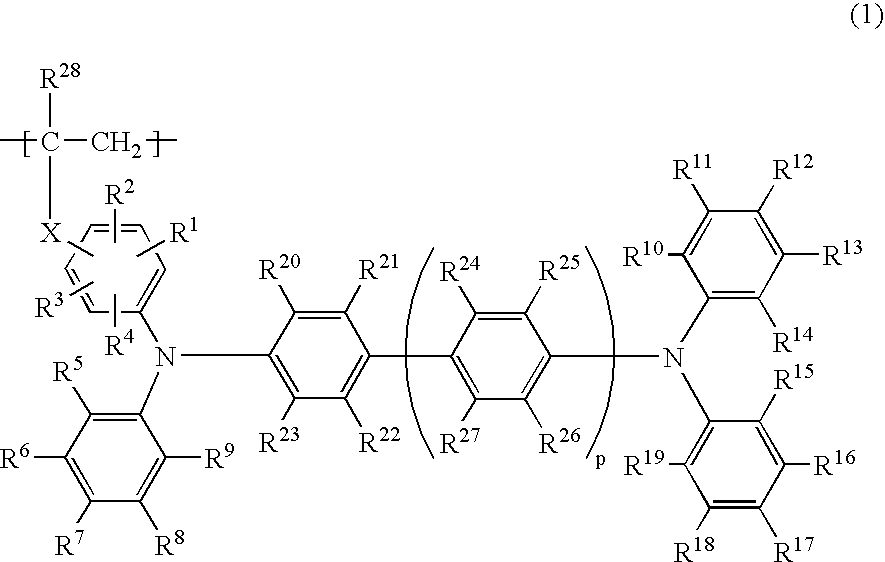Phosphorescent polymer compound and organic light emitting device using the same
a technology of phosphorescent material, which is applied in the direction of discharge tube/lamp details, indium organic compounds, natural mineral layered products, etc., can solve the problems that the ability of phosphorescent material and organic light emitting device using the same to show a sufficiently high efficiency at a low voltage has not yet been obtained, and achieves low power efficiency, high driving voltage, and reduced driving voltage
- Summary
- Abstract
- Description
- Claims
- Application Information
AI Technical Summary
Benefits of technology
Problems solved by technology
Method used
Image
Examples
example 1
Synthesis of Polymerizable Compound viTPD (1-1)
[0061]
[0062] A polymerizable group (a vinyl group) was bonded to TPD (N,N′-bis(3-methylphenyl)-N,N′-diphenylbenzidine) by the following procedures to synthesize the compound (1-1), hereinafter referred to as viTPD.
(1) Formylation of TPD
[0063] Under an argon atmosphere, 11.2 ml of phosphorus oxychloride 10 was added to 200 ml of dry N,N-dimethylformamide and stirred for 30 minutes, and then 51.7 g of N,N′-bis(3-methylphenyl)-N,N′-diphenylbenzidine(TPD) was added thereto and stirred at 80° C. for 2 hours. After the reaction, the reaction liquid was added dropwise to 2.5 L of a 1.0 M aqueous sodium carbonate solution, and the generated 15 precipitates were separated by filtration. The precipitates were dissolved in 500 ml of dichloromethane, and 500 ml of pure water was added to the resultant. The organic layer was dried over magnesium sulfate, concentrated under a reduced pressure, and purified by a silica gel column chromatography us...
example 2
Synthesis of Polymerizable Compound viPMTPD (2-1)
[0067]
(1) Ditolylation of 3,3′-dimethylbenzidine
[0068] Under an argon atmosphere, 80 ml of dry xylene was added to 5 g of 3,3′-dimethylbenzidine and 11.30 g of 3-iodotoluene, and heated to about 50° C. Thereto were added 6.82 g of potassium tert-butoxide, 230 mg of palladium acetate, and 460 mg of tri-tert-butylphosphine in this order, and the resulting mixture was stirred at 120° C. for 4 hours. The reaction liquid was cooled to the room temperature, thereto was added 50 ml of pure water, and then the liquid was extracted with ethyl acetate 2 times. The organic layer was dried over magnesium sulfate, concentrated under a reduced pressure, and purified by a silica gel column chromatography using a developing solvent of an ethyl acetate-hexane mixed solvent. After the solvent was distilled off, the residue was recrystallized from methanol to obtain 4.00 g of 3,3′-dimethyl-N,N′-di-m-tolylbenzidine (2-2) with a yield of 49%. The produ...
example 3
Synthesis of Copolymer Poly-viTPD-co-IrST)
[0074]
[0075] 920 mg of viTPD (1-1) produced in Example 1 and 80 mg of IrST (formula (3-1), synthesized according to a method described in JP-A-2003-113246) were placed in an airtight vessel, and thereto was added 9.0 ml of dry toluene. To this was added 181 μl of a 0.1 M toluene solution of V-601 manufactured by Wako Pure Chemical Industries, Ltd., and the resulting liquid was subjected to freeze deaeration 5 times. The vessel was closed under vacuum, and the liquid was stirred at 60° C. for 72 hours. After the reaction, the reaction liquid was added to 300 ml of acetone dropwise to generate precipitates. The precipitates were purified by repeating reprecipitation in a toluene-acetone solvent 2 times, and vacuum-dried at 50° C. overnight, to obtain 750 mg of a pale yellow solid of poly-(viTPD-co-IrST). By GPC measurement, it was estimated that the obtained copolymer had a number average molecular weight (Mn) of 19,700, a weight average mole...
PUM
| Property | Measurement | Unit |
|---|---|---|
| external quantum efficiency | aaaaa | aaaaa |
| external quantum efficiency | aaaaa | aaaaa |
| external quantum efficiency | aaaaa | aaaaa |
Abstract
Description
Claims
Application Information
 Login to View More
Login to View More - R&D
- Intellectual Property
- Life Sciences
- Materials
- Tech Scout
- Unparalleled Data Quality
- Higher Quality Content
- 60% Fewer Hallucinations
Browse by: Latest US Patents, China's latest patents, Technical Efficacy Thesaurus, Application Domain, Technology Topic, Popular Technical Reports.
© 2025 PatSnap. All rights reserved.Legal|Privacy policy|Modern Slavery Act Transparency Statement|Sitemap|About US| Contact US: help@patsnap.com



